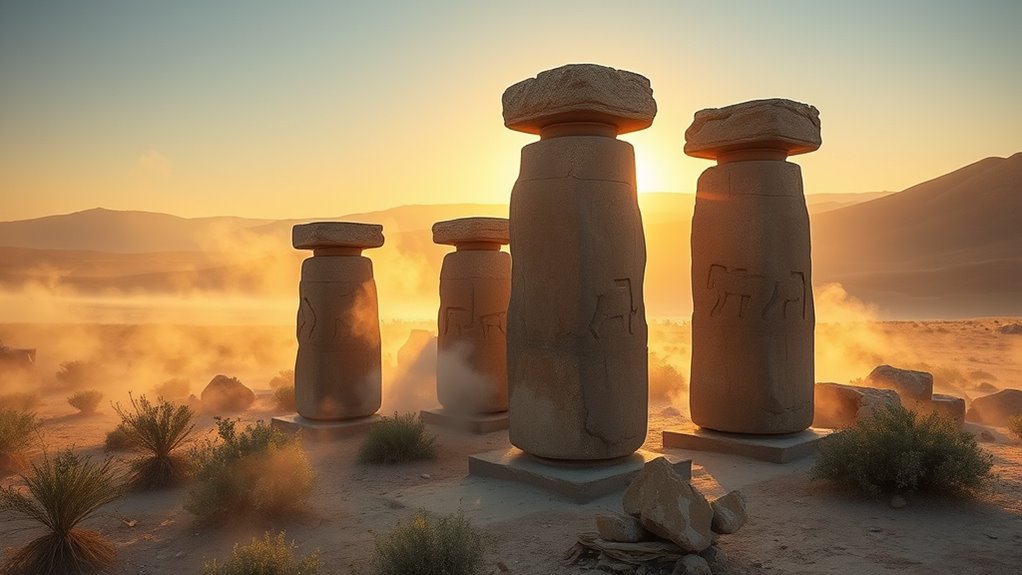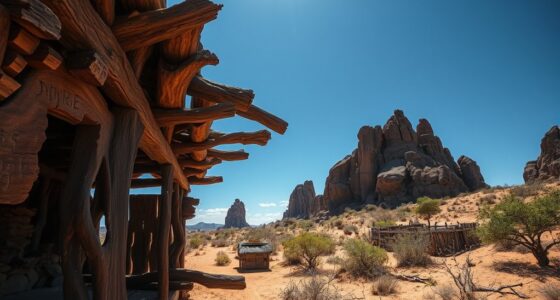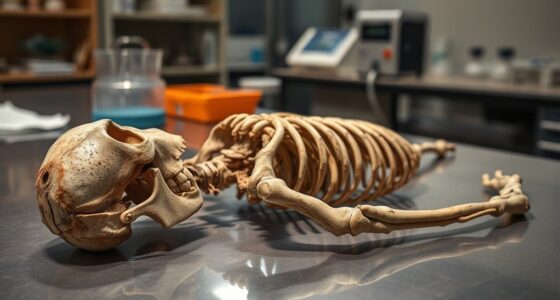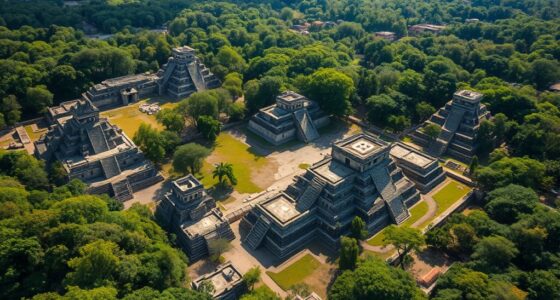Many sites near Göbekli Tepe show that the Neolithic Revolution wasn’t just about farming but also involved complex spiritual practices. These sister sites feature large monuments, carved symbols, and rituals that bonded communities and connected them with unseen forces. They reveal early humans used architecture and symbolism to express beliefs, shape society, and reinforce social cohesion. If you’re curious, exploring these sites uncovers new details about how spirituality influenced early transformative societies.
Key Takeaways
- Numerous sister sites reveal that early monumental architecture was widespread beyond Göbekli Tepe, indicating complex social and ritual activities.
- These sites feature carved symbols and abstract motifs, emphasizing spiritual and ceremonial functions in Neolithic societies.
- Monuments served as sacred gathering spaces, fostering social cohesion and religious practices related to fertility and nature.
- The construction of such sites reflects a cultural shift where spiritual motives influenced societal development alongside agriculture.
- Recognizing these sister sites broadens understanding of the Neolithic Revolution as a spiritual and social transformation, not solely an agricultural one.
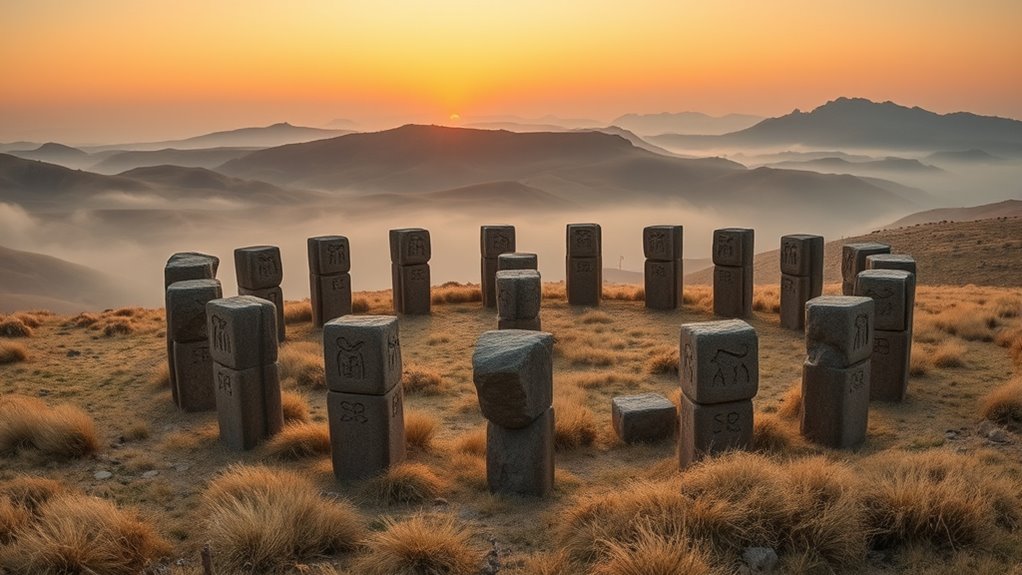
While Göbekli Tepe is the most famous example of early monumental architecture, it is not alone. Across the landscape, other sites reveal that this period was marked by complex social and religious activities, challenging the idea that Neolithic society was primarily driven by simple farming practices. These sister sites showcase how early communities engaged in intricate rituals, often symbolized through carefully carved stones and structures that served as stages for ritual symbolism. You might think that Neolithic agriculture was the central force behind societal change, but these sites suggest that spiritual and ceremonial motives played a significant role in shaping early human settlements.
At these sites, you see evidence of ritual symbolism embedded in every aspect of construction. Unlike later civilizations, where religion was often integrated into written texts, these early societies relied heavily on visual and material symbols. You notice carved animals, abstract motifs, and humanoid figures that seem to serve as conduits for spiritual beliefs. These symbols weren’t just decorative—they were crucial for rituals that bound communities together, marking sacred spaces and reinforcing social cohesion. As you explore, you realize that the act of building and decorating these monuments was a form of communication with the divine, or perhaps with ancestral spirits, emphasizing the importance of ritual in their worldview.
Early monuments feature carved animals, abstract motifs, and humanoid figures as symbols for spiritual communication and social unity.
These sites also highlight that the Neolithic Revolution was not solely about the adoption of farming but involved a shift in cultural and religious practices. The presence of large, communal structures indicates that people gathered for shared rituals, possibly to ensure good harvests or to honor deities associated with fertility and nature. Such activities suggest that ritual symbolism was central to their understanding of the world and their place within it. You see that these monuments functioned as more than mere markers of territory—they were embodiments of beliefs, serving as physical representations of spiritual ideas that governed daily life.
Furthermore, these sister sites underscore that the development of Neolithic society was a complex interplay of subsistence strategies and spiritual needs. While Neolithic agriculture provided stability and resources, it was the ritual symbolism associated with these sites that fostered social bonds and collective identity. You realize that the construction of these monuments was an act of cultural expression, rooted in a desire to connect with the unseen forces believed to influence their environment. Additionally, understanding the spiritual significance of symbols used in their rituals helps us appreciate how early humans expressed their beliefs beyond tangible structures. In this way, early humans used architecture not just to organize space but to express and reinforce their spiritual worldview, shaping the course of the Neolithic Revolution far beyond mere farming advances.
Frequently Asked Questions
How Do Sister Sites Differ Architecturally From Göbekli Tepe?
When comparing sister sites to Göbekli Tepe, you’ll notice architectural variations that reflect different construction techniques. These sites often feature more complex or refined designs, with larger or more numerous stone carvings and pillars. Unlike Göbekli Tepe’s massive, T-shaped pillars, sister sites might use different stone arrangements or smaller structures, indicating evolving building methods and cultural shifts. These differences highlight how architectural styles adapted over time across various Neolithic communities.
What Unique Artifacts Have Been Discovered at These Sister Sites?
You’ll find that these sister sites feature unique artifacts like figurines and rare carvings not seen at Göbekli Tepe. These artifacts reveal different cultural expressions and religious practices, giving you insight into early Neolithic communities. The figurines often depict animals or human forms, while the carvings include intricate symbols. Such discoveries help you understand the diverse ways ancient peoples expressed their beliefs and social identities across different sites.
Are There Evidence of Similar Ritual Practices Across All Sites?
You’ll find that ritual similarities across these sites suggest a shared cultural or spiritual framework. The ceremonial consistency, seen in similar stone carvings and layout designs, indicates that these practices might have been widespread. This pattern points to a coordinated religious or social tradition, highlighting how interconnected ancient communities were in their ritual expressions. Such evidence challenges ideas of isolated development and suggests a broader, unified approach to spirituality during the Neolithic period.
How Did These Sites Influence Early Societal Structures?
It’s ironic how these ancient sites, rather than just being mysterious monuments, actually shaped societal development. You see, as you explore their ritual evolution, you realize they fostered social cohesion, hierarchy, and shared beliefs. These sites didn’t just mark spiritual practices but laid the groundwork for complex societal structures. In doing so, they transformed early communities into organized societies, proving that ritual was the catalyst for lasting societal change, not mere superstition.
What Future Research Is Planned for Uncovering More About These Sites?
You’re curious about future research on these ancient sites. Researchers plan to use advanced excavation techniques to uncover more details while addressing preservation challenges that threaten these irreplaceable structures. You’ll see efforts focused on non-invasive methods like ground-penetrating radar and careful excavation to protect the sites’ integrity. This approach aims to deepen our understanding of early societies, ensuring these archaeological treasures remain for future study.
Conclusion
By exploring Göbekli Tepe’s sister sites, you realize that the Neolithic revolution wasn’t just about farming—it was about community and shared beliefs. Imagine visiting a nearby site where you see similar carved stones, sparking a sense of connection across ancient societies. These sites remind you that human progress often builds on collective effort and ideas, shaping our history in ways we’re still uncovering. Your understanding deepens, showing that our roots run through many intertwined stories.
